Swarm Removal
Swarm Removal
Last summer we had the opportunity to attend a Swarm Removal class sponsored by the Collin County Hobby Beekeepers Association and taught by John Talbert and Ted Vance. What an amazing experience it was! This house had been scheduled for demolition but when the bees were discovered work had to stop. The beekeepers called to remove them decided that this would be a good opportunity to share their skills with others, and so the class was formed. If this house had not been scheduled for removal, more care would have been taken in exposing the hives.
Take a look at the pictures below and pray that bees never move into your house. Removing them, when done correctly, is an expensive and time consuming proposition.
A word of warning: Be wary of exterminators who say they will just kill the bees without removing the hives. They will indeed kill the bees, but then you have a ceiling or wall full of decaying bees, which can be quite smelly. In addition, with the bees gone, there is no one to fan the hives to prevent the beeswax from melting, so melt it does and soon you have beeswax and honey oozing into the house. Not a pretty sight (or aroma)!
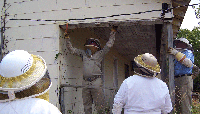
|
The first step in removing the hive(s) is to find it. Bees were seen flying into this area so shingles are removed.
[Click on picture to enlarge.] |
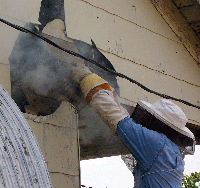
|
Bingo! One hive is found and smoked.
[Click on picture to enlarge.] |
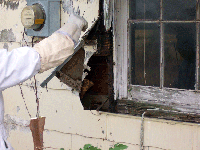 |
Another hive is found.
[Click on picture to enlarge.] |
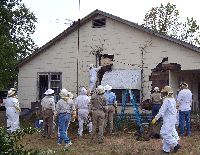 |
Photograph showing location of hives, and the students in the class. Can you tell the experienced beekeepers from the novices? (Hint, check out the suits.)
Yes, it does look like a scene from E.T.
[Click on picture to enlarge.] |
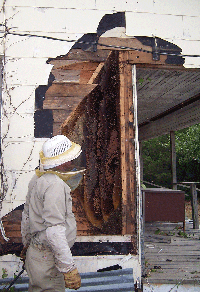 |
The hive on the right is exposed. It is decided that this hive will be used to demonstrate how to move the hive into a super.
[Click on picture to enlarge.] |
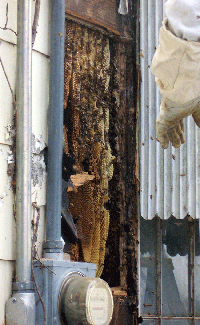 |
The bottom of the other hive exposed. But how far up does it go?
[Click on picture to enlarge.] |
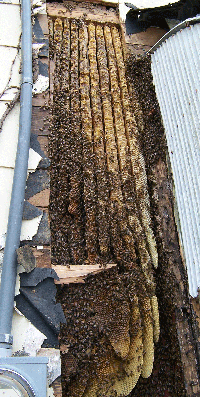 |
It goes a LONG way up (about 6 - 7 feet). This hive is selected to demonstrate the other method for bee removal - vacuuming. Click on the picture to see the enlarged image and note all the honey at the top of the combs.
[Click on picture to enlarge.] |
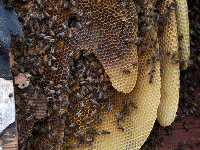 |
A closeup of the bottom of the hive.
[Click on picture to enlarge.] |
 |
Vacuuming out the bees. We were fortunate that we had access to electricity.
[Click on picture to enlarge.] |
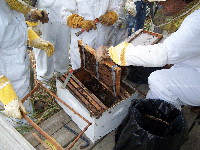 |
Framing up the comb from the first hive. Brood comb (comb containing eggs) is cut from the building and duct taped into the empty frame. Note the empty frame in the lower left corner. It is essential that you capture the queen.
John Talbert, who took possession of the salvaged hive reported that they were doing fine.
[Click on picture to enlarge.] |











